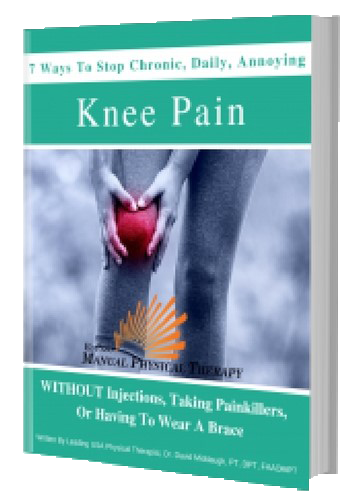TAP TO CALL (915) 503-1314

WHY A MUSCLE IMBALANCE IS CAUSING YOU PAIN AFTER A KNEE REPLACEMENT
I’m going to explain how our muscle imbalance affects knee arthritis and how it can still affect you even after you’ve had a knee replacement. This is why some people have a failed knee replacement experience where they still have chronic pain even after they’ve already had their knee replacement, especially if they’ve been back to their doctor and have been told the X-rays look fine, everything’s normal, your knees bending just fine and straightening just fine.
There’s nothing else that can be done. Here’s why you might still have knee problems. So let me draw you a graph to explain this. On this axis here, we have more. And down here we have less. And let’s put age down here. So we’ll start at the fifties. We’ll do sixties about right here. 70s. And we’ll put eighties down here just for teaching purposes.
Now, let’s say you start to develop knee osteoarthritis in your fifties and if, of course, you have less of it at the beginning, but as time goes on, you develop more and more and then it gets to a point where it’s not tolerable and you have a knee replacement surgery. At the same time, you are developing a muscle imbalance and you might be doing exercise to help your knee or osteoarthritis, which will influence your overall strength.
So let me draw the strength line for you here. Oh, let me label this one real quick. We’ll say this is knee arthritis. We’re talking about osteoarthritis for arthritis. And then here’s strength. Let’s just say your strength is at some level right here. And when you go to exercise, it might come up. And then if you have a flare up in your arthritis, it might come down a bit.
Then once you recover, you might strengthen again. It might come down as you have a flare up in your arthritis. And then most people, as they get more severe in their arthritis, they kind of stay the same, if not even lose some strength. And we’ll say that’s around 70, maybe late sixties. Now, let’s talk about the muscle imbalance and we’re going to label this one, too.
This is strength. I’m going to write STR for strength. Now for the muscle imbalance, that just means that there’s some muscles on one side of the body that are stronger than the other. And if we’re talking about the knees specifically because muscle imbalances can happen just about anywhere in the body, in the knee, it’s usually the quad muscles, the muscles that are right here on the front of your thigh that get way too strong.
And it’s the muscles on the back of the hip back here, usually glutes that are too weak. And they put the knee joint at a at an imbalance. So there’s extra forces that are happening in a bad way, a way that the knee joint is not designed to take. That’s what causes knee arthritis. So your imbalance might be kind of low down here.
And as you strengthen, if you’re strengthening incorrectly, the imbalance goes up. Then as you take some time off to recover, you might plateau and then as you strengthen, it goes up again. Then you recover because you flared up and then here it can get worse as you get further into your knee arthritis because you do less. So the weakest muscles get even weaker over time.
So I’m just going to put muscle imbalance. MI right there. Then let’s say you’re fed up with dealing with this knee problem because everybody gets that point when they have a knee replacement, obviously, and you have a knee replacement, boom, all of a sudden your knee arthritis is gone because you have the joint replaced. So there’s no more knee arthritis.
But what happens is strength and muscle imbalance. Let’s draw those lines for you here. So right after surgery, you’re going to lose strength. So strength will dip. Then you’ll have physical therapy, hopefully to gain some of that strength back. So you’ll start to recover strength. But typically, after knee replacement, people don’t get very strong. So they kind of level out at a certain level, often because their knee isn’t the same after the knee replacement.
They just aren’t as active as they were before. They gradually decline in strength. Meanwhile, that muscle imbalance, which requires strengthening muscles in a certain way, will get worse over time. So even though you had the knee replacement didn’t take care of the muscle imbalance that might, it’s going to get worse after surgery. And then as you strengthen, it tends to get worse and it just tends to go up this way over time here because of the muscle imbalance getting worse and strength going down, strength in the in the glutes usually goes down and the quads strength relative to the glutes goes up.
So that puts them it puts you in a further imbalance. That’s what causes more pain after the knee replacement because you’re adding tension, you’re adding bad forces to the knee joint where the prosthetic, where the implant attaches to the bone. You can add extra pressure to it that can be aggravating for a knee. So what we want to do ideally is get this imbalance to go down this way.
But what has to be done is you have to strengthen muscles the right way. You need more strength and this needs to go this way. This right here is how we fix chronic pain after knee replacement. If you want more information on how to help a failed knee replacement or chronic pain after you’ve had a knee replacement go down the description below.
And there’s a playlist called Failed Knee Replacement Help. Hit that link. You’ll see all our videos we’ve got here on YouTube. And also I’ve got a program for you called the Failed Knee Replacement Recovery Program. You can learn more about that in the link in the description below. Hey, thanks so much for watching. Please like this video. If it helped you out, share it with somebody you think needs to hear this and please subscribe to our channel and turn on our notification bells so that you don’t miss out on any of the videos we post every week. I’ll see you in the next video. Bye bye.
Would You Like To Talk With A Specialist?
Appointments and Questions Call: (915)503-1314
EL PASO MANUAL PHYSICAL THERAPY
2601 E. Yandell Drive, Suite 232
El Paso, Texas 79903
© 2023 El Paso Manual Physical Therapy, PLLC, All Rights Reserved
